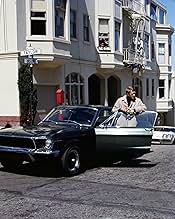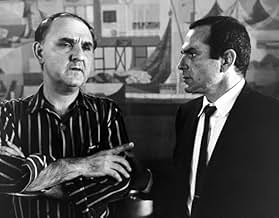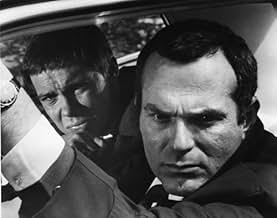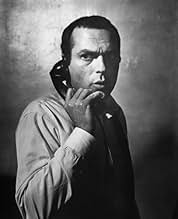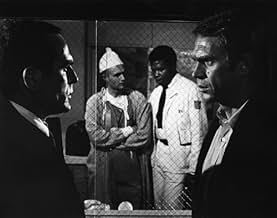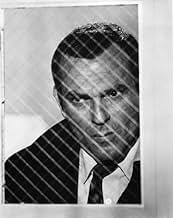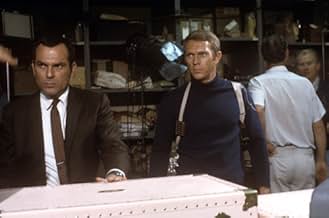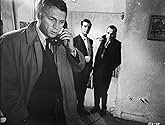Um policial de San Francisco, corajoso e sem escrúpulos, decide encontrar o chefe que matou a testemunha baixo sua proteção.Um policial de San Francisco, corajoso e sem escrúpulos, decide encontrar o chefe que matou a testemunha baixo sua proteção.Um policial de San Francisco, corajoso e sem escrúpulos, decide encontrar o chefe que matou a testemunha baixo sua proteção.
- Direção
- Roteiristas
- Artistas
- Ganhou 1 Oscar
- 7 vitórias e 9 indicações no total
Vic Tayback
- Pete Ross
- (as Victor Tayback)
- Direção
- Roteiristas
- Elenco e equipe completos
- Produção, bilheteria e muito mais no IMDbPro
Avaliações em destaque
The late 1960s saw two classic, hard-boiled thrillers set in San Fransico; John Boorman's stylised 'Point Blank', and Peter Yates' 'Bullitt'. Calling your hero Bullitt might seem an unsubtle way to emphasise his macho qualities, but in fact Steve MacQueen plays him as a quiet man, not some wise-talking maverick: he does what he has to do, but takes no pleasure in his actions; and survives the roughness of his work not by becoming a monster, but simply by becoming a little less human. It's a believable portrait, and the film as a whole has a procedural feel: there are action scenes, but these are kept in their place in the overall design.
Today, the film is most famous for its celebrated car chase, which makes excellent use, as indeed does the movie as a whole, of the bay area locations, but is not actually shot that excitingly: the conclusion at the airport is more original, though it roots the film in the time when it was permissible to take a loaded gun onto a plane. But overall this is still a classy film, dry, exciting and bleak, and among the very best films of its day. William Friedkin's brilliant 'The French Connection', made a short while afterwards, would appear to owe it a debt.
Today, the film is most famous for its celebrated car chase, which makes excellent use, as indeed does the movie as a whole, of the bay area locations, but is not actually shot that excitingly: the conclusion at the airport is more original, though it roots the film in the time when it was permissible to take a loaded gun onto a plane. But overall this is still a classy film, dry, exciting and bleak, and among the very best films of its day. William Friedkin's brilliant 'The French Connection', made a short while afterwards, would appear to owe it a debt.
Despite having aged somewhat, Bullitt remains a tough, gritty, and altogether realistic portrait of police life in late sixties San Francisco. The film is of course most renowned for the spectacular (even by today's standards) car chase in which star Steve McQueen famously did his own stunt driving (I wonder what the insurance policy was like?!) Although McQueen didn't really have to stretch beyond his already established screen persona, he is perfect in the role. He is Bullitt like Connery is Bond. Maybe the role was tailored specifically for him. He also has Jacqueline Bisset (Cathy), who can more than hold her own with any Bond girl, to come home to! She adds a welcome domestic quality and the audience feels relieved that despite the unforgiving profession Bullitt works in, at least he has a good woman at his side. The location photography in beautiful San Francisco, the to-the-letter accurate procedural dialogue, the political infighting with the smarmy D.A. Chalmers (Robert Vaughn) and the brutally violent action scenes all complement the fine performances to create an entirely engrossing authentic crime drama. Watch for the great Robert Duvall in a minor role as the cabbie.
This movie is a great example of how style can prevail over substance in a film. The story is straight-forward enough, but nothing outstanding - Det. Bullitt is assigned to protect a witness who will testify against the mob. He must protect him for about 40 hours, but somehow, hitmen discover the location of the witness and gun him down before he can testify. Then Bullitt must find the hitmen, as well as deal with an identity twist concerning the witness.
However, the music score, tight direction, the car chase, McQueen's performance, and especially Robert Vaughn's performance as a ruthless politician make "Bullitt" worth watching. In fact the performances are excellent all the way through the cast (with the exception of Jacqueline Bisset, who's there only for eye candy and brings nothing special to her role).
Of course, the car chase is the most famous aspect of the film. Simply put, it's the best car chase ever filmed, bar none. It's been copied, and with today's technology, should have been exceeded. Yet it still stands alone. Why?
First, the presence of Steve McQueen - who else could bring it off as well as he did? Second, the era it came from, the late 60's. Films in those days didn't have chases, so it set the standard. There's no camera tricks or special effects to screw it up, what you see is what you get. It's just wouldn't be the same if one of today's big stars got in his BMW to chase another guy in a Porsche, complete with special effects, the obligatory explosions and slow-motion techniques.
If you've never seen it, watch it. If you have seen it, it still holds up after repeated viewings. 9 out of 10.
However, the music score, tight direction, the car chase, McQueen's performance, and especially Robert Vaughn's performance as a ruthless politician make "Bullitt" worth watching. In fact the performances are excellent all the way through the cast (with the exception of Jacqueline Bisset, who's there only for eye candy and brings nothing special to her role).
Of course, the car chase is the most famous aspect of the film. Simply put, it's the best car chase ever filmed, bar none. It's been copied, and with today's technology, should have been exceeded. Yet it still stands alone. Why?
First, the presence of Steve McQueen - who else could bring it off as well as he did? Second, the era it came from, the late 60's. Films in those days didn't have chases, so it set the standard. There's no camera tricks or special effects to screw it up, what you see is what you get. It's just wouldn't be the same if one of today's big stars got in his BMW to chase another guy in a Porsche, complete with special effects, the obligatory explosions and slow-motion techniques.
If you've never seen it, watch it. If you have seen it, it still holds up after repeated viewings. 9 out of 10.
What a change of pace this movie is as compared with its genre today. I'm no old fogey but would that modern directors become smart enough take several pages from its book.
The Bullit character is a precursor of Dirty Harry but a bit more cerebral. Stylistically, the director sets the stage beautifully for McQueen's Bullit. The movie has a European feel (director Peter Yates is a Brit) and achieves its dark mood through quiet understatement. The musical score for instance. Today, music is overly used, overly loud and manipulative. (i.e. in case you are not moved by this scene, here are a division of amplified violins to remind you to weep). In 'Bullit' the music is sparingly used and doesn't intrude at all. It complements the directorial style without setting the agenda.
The feeling of reserved naturalism is achieved through editing and dialogue. There really aren't very many lines in the movie and when characters do speak they are very succinct. Notice the last 15-20 minutes of the movie, most of which takes place at the airport. Hardly a line in it. There is none of the chattiness so prevalent today (especially post "Pulp Fiction") which is so tedious (unless the script is tip-top, which is rare).
Editing is, perhaps, its greatest strong point. The many long edits deserve equal credit with the dialogue in setting the low-key mood. The cinema verite dialogue of the airport scenes (and, say, the scene where McQueen and Don Gordon search the trunk) combined with the long cuts add greatly to understated feel while adding realism.
And the performances are top notch. The spare script helps McQueen shine since the taciturn moodiness fits his persona to a tee. There are very fine performances from all of the supporting cast, from Don Gordon to Bisset to Fell to Duvall to Oakland. This is a great movie for watching faces. Note the expressions of the hit men during the chase scene (just another example of this movie letting the little touches speak volumes).
The chase scene certainly deserves its billing as one of the best in movie history. Recently, 'The Transporter' was lauded for its opening chase sequence. The one in 'Bullit' is a marvel compared. In 'The Transporter' sequence I'm not sure there is a cut that lasts more than three seconds. In 'Bullit' it is again the editing which sets it apart here. The long edits give you the feel of acceleration and deceleration, of tire smoke and gears, of wind and the roller coaster San Francisco streets. You are given the time to place yourself in the frame. In short, 'Bullit' uses real craftsmanship. Films like 'The Transporter' use hundreds of quick edits to mimic the danger and immediacy of 'Bullit' but it comes across as hot air, confusion instead of clarity. The two scenes are perfect set pieces of easy (and hollow) Mtv-style flash versus real directorial substance.
The Bullit character is a precursor of Dirty Harry but a bit more cerebral. Stylistically, the director sets the stage beautifully for McQueen's Bullit. The movie has a European feel (director Peter Yates is a Brit) and achieves its dark mood through quiet understatement. The musical score for instance. Today, music is overly used, overly loud and manipulative. (i.e. in case you are not moved by this scene, here are a division of amplified violins to remind you to weep). In 'Bullit' the music is sparingly used and doesn't intrude at all. It complements the directorial style without setting the agenda.
The feeling of reserved naturalism is achieved through editing and dialogue. There really aren't very many lines in the movie and when characters do speak they are very succinct. Notice the last 15-20 minutes of the movie, most of which takes place at the airport. Hardly a line in it. There is none of the chattiness so prevalent today (especially post "Pulp Fiction") which is so tedious (unless the script is tip-top, which is rare).
Editing is, perhaps, its greatest strong point. The many long edits deserve equal credit with the dialogue in setting the low-key mood. The cinema verite dialogue of the airport scenes (and, say, the scene where McQueen and Don Gordon search the trunk) combined with the long cuts add greatly to understated feel while adding realism.
And the performances are top notch. The spare script helps McQueen shine since the taciturn moodiness fits his persona to a tee. There are very fine performances from all of the supporting cast, from Don Gordon to Bisset to Fell to Duvall to Oakland. This is a great movie for watching faces. Note the expressions of the hit men during the chase scene (just another example of this movie letting the little touches speak volumes).
The chase scene certainly deserves its billing as one of the best in movie history. Recently, 'The Transporter' was lauded for its opening chase sequence. The one in 'Bullit' is a marvel compared. In 'The Transporter' sequence I'm not sure there is a cut that lasts more than three seconds. In 'Bullit' it is again the editing which sets it apart here. The long edits give you the feel of acceleration and deceleration, of tire smoke and gears, of wind and the roller coaster San Francisco streets. You are given the time to place yourself in the frame. In short, 'Bullit' uses real craftsmanship. Films like 'The Transporter' use hundreds of quick edits to mimic the danger and immediacy of 'Bullit' but it comes across as hot air, confusion instead of clarity. The two scenes are perfect set pieces of easy (and hollow) Mtv-style flash versus real directorial substance.
Probably the most beautiful car chase in all of Hollywood cinema. That alone is worth the price of admission to the theater. Apart from that, I came to this movie after the chapter Quentin Tarantino dedicated to it in his recent book. Deservedly so, I would say. The forerunner of tough and pure cops, Bullitt has charisma and charm to spare, thanks in large part to Steve McQueen. The role fits him perfectly. The soundtrack is also one of the most iconic around, Lalo Schifrin knew what he was doing. Thank you Quentin for introducing me to this old film, which I include among the classics of the genre.
Você sabia?
- CuriosidadesWhile filming the scene where the giant airliner taxis just above Steve McQueen, observers were shocked that no double was used. Asked if the producers couldn't have found a dummy, McQueen wryly replied, "They did."
- Erros de gravaçãoDuring the chase sequence, the same green Volkswagen Beetle is seen at least 4 different times in 4 different locations in a period of not more than 1 minute.
- Versões alternativasDuring the car chase, when the Charger goes wide on a corner and hits a camera, the film was salvaged and red frames added at the end, to give a "point of impact" impression. Despite this gag being in situ for decades, on the current Cinemax Asia print, someone has seen fit to completely remove these last frames of the shot.
- ConexõesEdited into Cidade em Chamas (1979)
Principais escolhas
Faça login para avaliar e ver a lista de recomendações personalizadas
- How long is Bullitt?Fornecido pela Alexa
Detalhes
- Data de lançamento
- País de origem
- Idioma
- Também conhecido como
- Đại Tá Bullitt
- Locações de filme
- Coffee Cantata, Union Street, San Francisco, Califórnia, EUA(jazz club and restaurant scene)
- Empresa de produção
- Consulte mais créditos da empresa na IMDbPro
Bilheteria
- Orçamento
- US$ 5.500.000 (estimativa)
- Faturamento bruto nos EUA e Canadá
- US$ 511.350
- Fim de semana de estreia nos EUA e Canadá
- US$ 408.627
- 7 de out. de 2018
- Faturamento bruto mundial
- US$ 512.162
Contribua para esta página
Sugerir uma alteração ou adicionar conteúdo ausente




